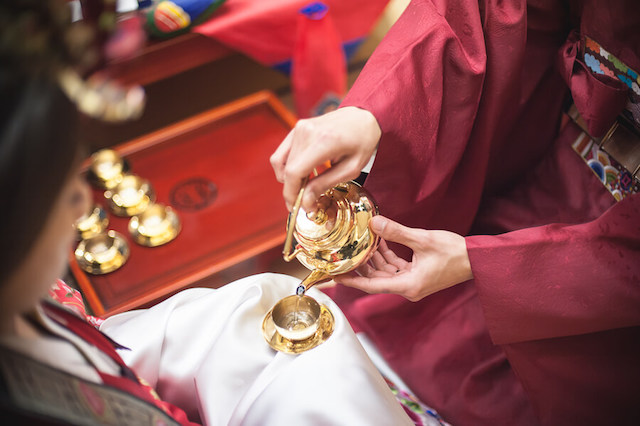South Korea is known for its rich culture and traditions. However, in the wedding department, that may not be the case. With westernisation comes embracing western ideals and tradition and as such, the country is seeing a rise in western marriage customs.
Whilst western marriage ceremonies are now the norm, there are still a handful of couples who prefer to adhere to their traditional set of rituals and customs. Dive into the 5 stages that make up a traditional Korean wedding and the significant customs observed at every step.
1. Eui Hon [의혼 (Matchmaking)]
In simple terms, 의혼 (eui hon) refers to the matchmaking process that preludes the marriage proposal. Contrary to its seemingly straightforward purpose, the process is anything but. Professional matchmakers would gather information on those who have yet to marry, including their social class, education levels and even family lineages. Once they decided on a match, they would have respective parents meet and discuss the possibility of marrying their children. The parents would also meet their potential children-in-law.
The prospect of marriage gets a green light when the groom’s family would craft out a proposal of marriage to send to the bride’s parents. The latter will then either accept or decline the offer, on behalf of their daughter.
2. Napchae [납채 (Setting the Date)]
Traditional Korean beliefs state that one’s life path has been determined pre-birth. So, to prepare for one’s life events, they will have to look at the year, month, date and exact hour of their birth.
Seeing as how marriage is a significant milestone, the families back then would consult a fortune teller to figure out the best date for the wedding. The groom’s side will deliver the information to the bride’s family, who will then bring this to their fortune teller. Once a date has been settled, the bride’s family will inform the groom’s family about the wedding date.
3. Napp’ae (Betrothal Gifts)
Prior to the wedding ceremony, the groom’s family will present betrothal gifts in a box called a 함 (hahm) via a band of the groom’s closest friends. This custom involves the groom’s friends arriving right outside the bride’s house to ‘sell’ the hahm to the bride’s family. The latter will then ‘purchase’ the betrothal gifts, not forgetting to negotiate for a lower price.
The hahm usually consisted of 3 items: the marriage paper that symbolises the wife’s commitment to only one husband, a collection of red and blue fabrics that embodies the philosophy of 음 (Eum) and 양 (Yang) (Yin and Yang), and lastly, a collection of other valuables for the bride.
4. Kunbere (Wedding Ceremony)
Most traditional Korean weddings will take place at the bride’s home. Also known as the kunbere, the wedding ceremony starts with the bride and groom bowing to each other before sharing a special Korean white wine, which is later poured into two halves of a gourd. Following the wedding vows and the sipping of the wine, the newlywed, their families and the guests will share a simple meal.
5. Pyebaek [폐백(Post-Wedding Rituals)]
Held after a few days after the wedding ceremony, the 폐백 (pyebaek) involves only family members. Unlike the official ceremony, this post-wedding ritual is done in the groom’s house. The bride is then introduced to her in-laws as their daughter-in-law, indicating a shift in family structure. The bride has left her family to be one with her husband’s family.
The bride will offer her in-laws Korean dates and chestnuts to symbolise future children. The newlywed will also offer cups of wine to the parents. The parents would advise and dispense wisdom on marriage life, before throwing the dates and chestnuts back at the bride. The act symbolises blessings for fertility, which the bride has to then attempt to catch with her wedding skirt.
Modern Weddings With Traditional Practices
One traditional practice that is still alive today is the wearing of the traditional Korean attire, 한복 (hanbok). This is seen not so much with the bride and groom – who will wear a white wedding dress and a black suit respectively – but rather, it is still common practice for mothers to don the traditional attire. The mother of the groom will wear a blue hanbok whilst the mother of the bride will wear a pink hanbok. These colours again symbolise the philosophy of Eum and Yang.
That said, most Koreans have embraced modern wedding ceremonies. There are a few that would honour the traditional wedding customs, of course, with a few tweaks here and there. For instance, since you already know who you’re getting married to, there’s no need to participate in a eui hon.
Learn all the interesting traditional Korean customs and traditions when you enrol in a Korean language course at Singapore’s number 1 Korean language school, Sejong. We provide a structured and engaging curriculum for all levels: from basic to further advanced! Give us a call today!


